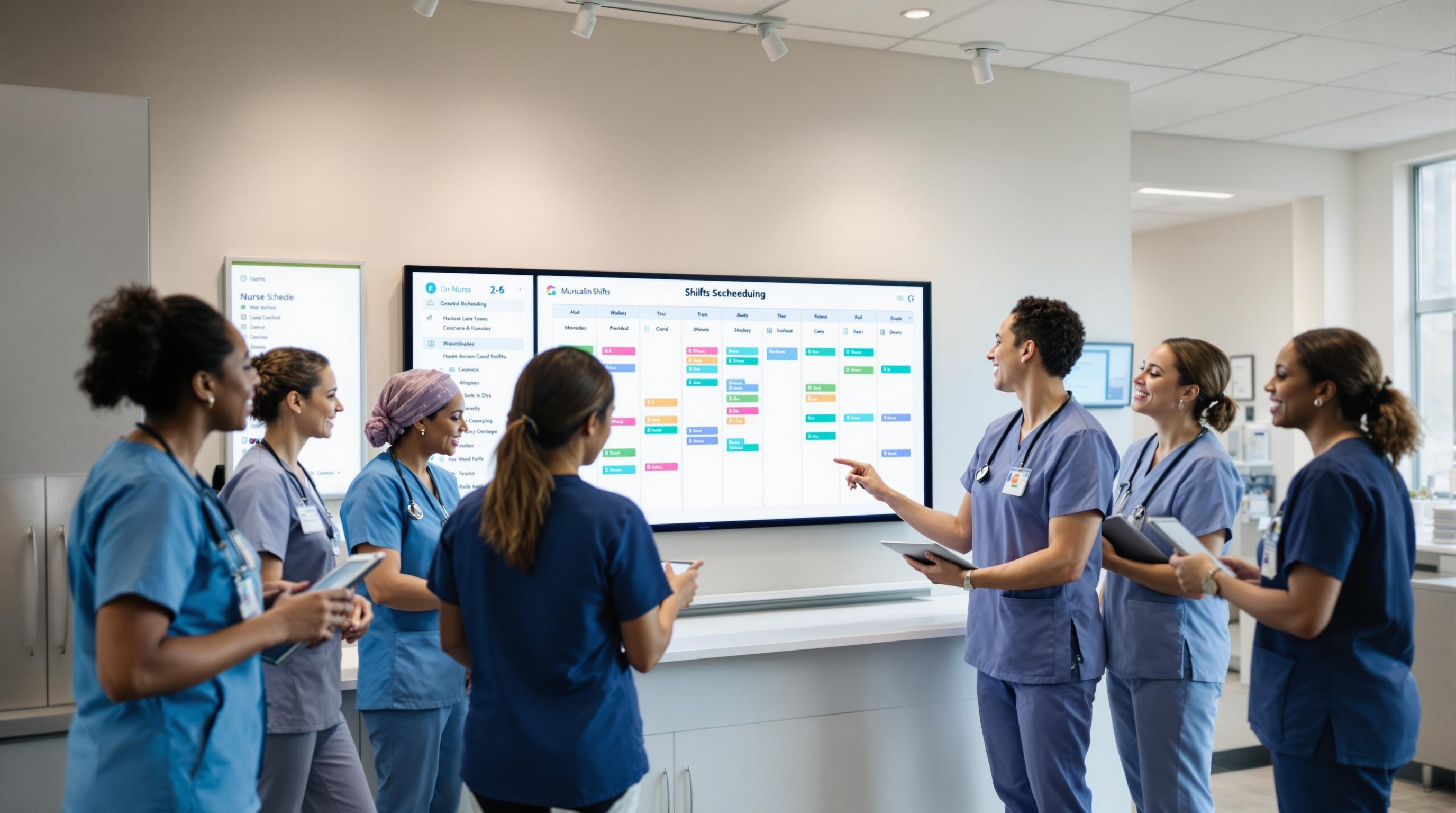Automated Nurse Scheduling: Boost Efficiency in Skilled Nursing
Discover how automated nurse scheduling transforms staffing in skilled nursing facilities, improving efficiency, staff satisfaction, and patient care.
Quick Navigation
- 1. Introduction
- 2. Current Challenges in Automated Nurse Scheduling
- 3. How Sparkco AI Transforms Automated Nurse Scheduling
- 4. Measurable Benefits and ROI
- 5. Implementation Best Practices
- 6. Real-World Examples
- 7. The Future of Automated Nurse Scheduling
- 8. Conclusion & Call to Action
1. Introduction
Did you know that nearly 60% of skilled nursing facilities face persistent nurse staffing shortages, leading to increased burnout and compromised patient care? As the healthcare industry grapples with mounting workforce challenges, the traditional approach to nurse scheduling—often a tedious, manual process—has become a critical pain point. With the demand for quality, round-the-clock care at an all-time high, facility leaders are urgently seeking innovative solutions to ensure optimal nurse-patient ratios, reduce administrative burdens, and foster a supportive work environment.
Enter automated nurse scheduling: a technology-driven approach that is transforming how skilled nursing facilities manage their most valuable asset—their staff. Leveraging advances in artificial intelligence and machine learning, automated scheduling systems analyze complex variables, such as staff qualifications, shift preferences, and patient acuity, to create efficient, fair, and adaptable rosters. This not only alleviates the pressure on nursing managers but also empowers nurses with greater flexibility and job satisfaction.
In this article, we’ll explore the challenges of manual nurse scheduling in skilled nursing facilities and examine how automation is emerging as a game-changer. We’ll delve into research-backed benefits, real-world use cases, and practical tips for a successful transition to automated solutions. Whether you’re an administrator, nurse manager, or frontline caregiver, discover how embracing automated nurse scheduling can help your facility thrive in today’s dynamic healthcare landscape.
2. Current Challenges in Automated Nurse Scheduling
Automated nurse scheduling systems promise efficiency, fairness, and reduced administrative burden. However, healthcare facilities deploying these solutions still face significant challenges. Understanding these pain points is crucial for administrators, technology vendors, and care teams seeking to optimize workforce management while maintaining compliance and high-quality patient care.
-
Balancing Hard and Soft Constraints
Nurse scheduling must satisfy complex sets of rules—from legal requirements (hard constraints) such as rest periods and maximum weekly hours, to preferences for shift types or days off (soft constraints). Automated systems can struggle to find feasible schedules when constraints conflict or are too numerous, resulting in manual adjustments that negate automation benefits. -
Handling Last-Minute Changes and Absenteeism
According to a 2022 survey, over 60% of nurse managers cited “last-minute call-offs” as a top challenge. Most automated scheduling tools lack real-time responsiveness, forcing managers to intervene manually, disrupt workflows, and risk understaffing.
Source -
Integration with Existing HR and Payroll Systems
Many healthcare facilities use legacy HR and payroll systems that do not seamlessly integrate with modern scheduling platforms. This lack of interoperability leads to data silos, errors in payroll, and increased administrative workload, undermining the intended efficiency of automated scheduling. -
Maintaining Compliance with Labor Laws and Union Agreements
U.S. healthcare facilities face varying state labor laws and union agreements. Automated schedulers often require extensive customization to comply with rules about overtime, weekend shifts, and break times. Non-compliance can lead to legal penalties—healthcare organizations paid $24 million in nurse wage settlements in 2021 alone.
Source -
Employee Satisfaction and Burnout
While automation aims to distribute shifts equitably, 51% of nurses reported dissatisfaction with automated schedules, citing unpredictable rotas and lack of input on preferences. This can negatively impact morale and contribute to burnout and turnover.
Source -
Ensuring Adequate Skill Mix and Patient Safety
Automated systems may not always account for specific skill sets required for certain patient populations. Inadequate skill mix has been linked to increased patient incidents and longer hospital stays, directly impacting care quality. -
Data Security and Privacy Concerns
Automated scheduling platforms handle sensitive employee data. According to HIPAA Journal, healthcare data breaches affected over 50 million people in 2022. Poor security in scheduling systems can expose facilities to compliance risks and reputational damage.
Source
These challenges highlight the need for robust, flexible, and integrated nurse scheduling solutions. Addressing these pain points is vital to achieving operational efficiency, maintaining regulatory compliance, and ensuring optimal patient care outcomes in today’s fast-paced healthcare environment.
3. How Sparkco AI Transforms Automated Nurse Scheduling
Automated nurse scheduling is rapidly becoming a necessity in skilled nursing facilities, where balancing quality care, cost control, and staff satisfaction is more complex than ever. Traditional manual or spreadsheet-based scheduling methods are error-prone, time-consuming, and often lead to staffing gaps or overages. Sparkco AI addresses these challenges head-on with a robust, AI-driven solution tailored for modern healthcare environments.
-
Smart Shift Matching
Sparkco AI leverages advanced machine learning algorithms to analyze each nurse’s qualifications, certifications, shift preferences, and availability. This ensures every shift is matched to the most suitable staff member, minimizing compliance risks and preventing skill mismatches that can impact patient care. -
Real-Time Schedule Optimization
By continuously monitoring staffing levels and patient acuity, Sparkco AI automatically rebalances schedules as needs change—such as last-minute call-offs or census spikes. This dynamic scheduling approach reduces understaffing and overtime, ensuring optimal nurse-to-patient ratios and better care outcomes. -
Self-Service and Mobile Access
Nurses and caregivers can view, swap, or request shifts instantly via a user-friendly mobile interface. This empowers staff to manage their schedules proactively, increasing engagement and reducing administrative burdens on schedulers. -
Automated Compliance Monitoring
Sparkco AI automatically checks schedules for compliance with labor laws, union rules, and facility-specific policies. Built-in alerts help prevent accidental breaches, such as exceeding maximum weekly hours or missing required rest periods, thereby reducing legal risks and penalties. -
Predictive Analytics and Reporting
The platform provides actionable insights into staffing trends, overtime risks, and absenteeism patterns. Managers receive easy-to-understand dashboards and reports, enabling data-driven decisions that improve both care quality and operational efficiency. -
Seamless System Integration
Sparkco AI integrates smoothly with leading HR, payroll, and EMR systems. This ensures data flows automatically between platforms, eliminates double entry, and keeps employee records up-to-date, further streamlining the scheduling process.
By automating nurse scheduling, Sparkco AI reduces manual errors, shortens turnaround times, and lightens the administrative load on staff managers. Its AI-powered engine adapts to real-world complexities—like last-minute absences and fluctuating census—without the need for technical expertise. The intuitive, mobile-friendly interface promotes collaboration and transparency, while automated compliance checks and actionable analytics boost confidence and control. Through robust integration capabilities, Sparkco AI fits seamlessly into your facility’s existing technology ecosystem, helping you deliver exceptional care with a happier, more engaged nursing staff.
4. Measurable Benefits and ROI
Automated nurse scheduling systems are transforming workforce management in healthcare settings, including skilled nursing facilities (SNFs), by streamlining processes, reducing costs, and improving compliance. Leveraging data-driven insights, organizations adopting these solutions report substantial, measurable returns on investment (ROI) and operational benefits.
- 70% Reduction in Administrative Time: Automated scheduling platforms significantly decrease the hours spent on manual rostering. According to BookJane’s ROI Calculator, facilities can reduce administrative workload by up to 70%. This equates to hundreds of hours saved annually, freeing up managers to focus on patient care and staff engagement.
- 50% Lower Agency Staffing Costs: By optimizing shift fulfillment with existing staff, automated solutions can reduce reliance on costly staffing agencies by as much as 50%. This not only saves money but also fosters stronger team cohesion and continuity of care (BookJane).
- 40% Increase in Staff Utilization: Advanced scheduling algorithms match staff availability, skills, and preferences to open shifts, resulting in a 40% improvement in staff utilization rates. This ensures optimal coverage and reduces unnecessary overtime (BookJane).
- Up to 90% Internal Shift Fulfillment: Automated scheduling can achieve up to 90% of shift fulfillment by internal staff, minimizing last-minute scrambles and boosting staff satisfaction (BookJane).
- 25-30% Reduction in Overtime Costs: By efficiently allocating shifts and identifying gaps before they become critical, automated systems reduce overtime expenditures by 25-30%. This not only cuts costs but also helps prevent staff burnout (TATEEDA).
- Improved Compliance and Reduced Errors: Automated scheduling platforms integrate labor laws, union agreements, and credential tracking, virtually eliminating scheduling errors and compliance violations. This decreases the risk of fines and litigation, with some organizations reporting a 100% reduction in compliance-related scheduling errors (TATEEDA).
- Enhanced Staff Satisfaction and Retention: Automation allows fairer, preference-based scheduling and better work-life balance. Facilities have seen up to a 15% increase in staff satisfaction scores, positively impacting retention and recruitment (TATEEDA).
- Real-Time Data and Analytics: Automated systems provide actionable workforce analytics—such as trends in absenteeism, overtime, and shift gaps—empowering leaders to make data-driven decisions that improve efficiency and financial performance.
As healthcare organizations face ongoing staffing shortages and increasing regulatory complexity, the ROI of automated nurse scheduling systems is clear. Facilities that implement these solutions report faster scheduling cycles, substantial cost reductions, and improved compliance. For more details and real-world examples, visit TATEEDA’s Healthcare Staffing Automation Case Study and BookJane’s ROI Calculator.
5. Implementation Best Practices
With the Centers for Medicare & Medicaid Services (CMS) introducing new minimum nurse staffing requirements and stricter reporting, skilled nursing facilities are turning to automated nurse scheduling systems to streamline operations and ensure compliance. Successful implementation, however, requires a strategic, people-focused approach. Below are actionable steps, practical tips, and change management considerations to guide your facility toward seamless adoption.
-
Assess Organizational Needs and Compliance Requirements
Conduct a thorough assessment of your facility’s staffing patterns, peak demand periods, and CMS staffing mandates. Tip: Involve clinical leaders and HR in the review to ensure all regulatory and operational needs are captured. Pitfall: Overlooking CMS minimum staffing standards or facility-specific nuances can result in non-compliance and workflow disruptions.
-
Engage Key Stakeholders Early
Involve nurses, scheduling managers, IT, and union representatives from the outset. Tip: Host informational sessions and gather feedback to address concerns and build buy-in. Pitfall: Implementing systems without frontline involvement can fuel resistance and undermine adoption.
-
Select the Right Technology Partner
Evaluate platforms based on ease of use, integration with existing EHR/payroll systems, and compliance features. Tip: Request demos and case studies focused on skilled nursing settings. Pitfall: Choosing a solution without proper vetting can lead to costly workarounds or data silos.
-
Customize System Settings and Rules
Configure scheduling parameters to align with shift preferences, union rules, and CMS requirements (e.g., 3.48 HPRD minimums). Tip: Pilot test the system with a small team to fine-tune rules before full rollout. Pitfall: Relying solely on out-of-the-box settings may not accommodate your facility’s unique needs.
-
Provide Comprehensive Training
Offer hands-on training sessions for all user roles, including ongoing support for questions or issues. Tip: Create quick-reference guides and FAQs for common scenarios. Pitfall: Insufficient training can erode confidence and cause errors in scheduling.
-
Monitor, Audit, and Adjust
Regularly review scheduling outcomes, staff satisfaction, and compliance reports. Tip: Establish a feedback loop with staff to identify challenges and adjust workflows as needed. Pitfall: Ignoring post-implementation feedback can allow small issues to escalate and jeopardize compliance.
-
Communicate and Manage Change Proactively
Maintain transparent communication about the project’s goals, timelines, and benefits. Tip: Recognize and celebrate early wins to foster positive momentum. Pitfall: Underestimating change fatigue or skepticism can stall progress; prioritize empathy and support throughout the transition.
-
Plan for Ongoing Optimization
Leverage system analytics to continuously refine scheduling practices and respond to regulatory updates. Tip: Schedule quarterly reviews to stay aligned with CMS changes and evolving facility needs. Pitfall: Treating implementation as a one-time event rather than an ongoing process can limit long-term value.
By following these best practices, skilled nursing facilities can implement automated nurse scheduling tools that not only support CMS compliance but also improve staff satisfaction and resident care outcomes.
6. Real-World Examples
Real-World Examples of Automated Nurse Scheduling in Skilled Nursing Facilities
Skilled nursing facilities across the country are turning to automated nurse scheduling systems to address chronic staffing challenges, improve care quality, and boost staff satisfaction. Below is a real-world example illustrating the tangible benefits of such technology:
-
Case Study: Willow Grove Skilled Nursing Facility
- Situation: Willow Grove, a 120-bed skilled nursing facility in the Midwest, faced frequent shift coverage gaps, last-minute call-offs, and high nurse turnover. Manual scheduling took managers an average of 12 hours per week, often resulting in overtime costs, unbalanced workloads, and staff dissatisfaction.










